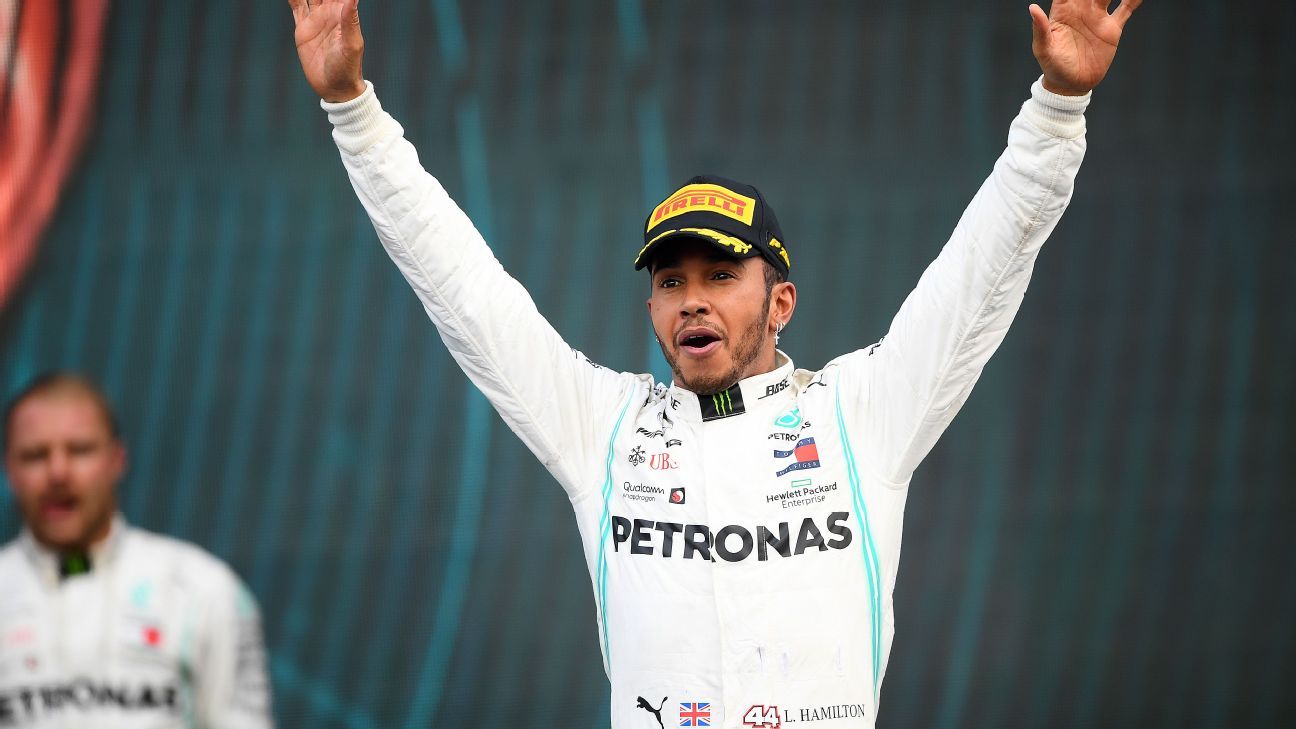MEXICO CITY – After securing victory in Mexico, Lewis Hamilton will arrive at next week’s U.S. Grand Prix within touching distance of his sixth world title. A gutsy strategy was needed to pull off win No.10 of his season, but Hamilton’s drive also underlined why he is about to have more titles to his name than the rest of the grid combined.
Jump to: How Max threw away a winning opportunity | Conservative strategy costs Ferrari
“Still I Rise”
Whatever you might think of Lewis Hamilton, it’s hard not to be thoroughly impressed with him on days like this. The Brit showed why he is on the verge of another championship with a remarkable drive at a circuit where few would have predicted a Mercedes win ahead of the weekend.
It included many hallmarks of a Hamilton victory. A bit of wheel-to-wheel action at the start with Sebastian Vettel off the line and then Max Verstappen through Turns 1 and 2 before he took to his in-car radio to voice concern that his team had made the wrong call on strategy by pitting him as early as they did, on lap 24 of 71.
“It feels like we stopped too early, man,” Hamilton told stand-in race engineer Marcus Dudley at one point, as he worked out in his head the various outcomes when Sebastian Vettel and Valtteri Bottas had made stops for fresher rubber later in the race than he had. This is not an uncommon part of a Hamilton race these days, as the reigning world champion frequently voices these sort of concerns over the radio.
It’s fair to see why he might have been a doubter early on. The strategy required him to take the hard tyres 47 laps to the finish — he asked at one point if the tyres could do that sort of stint. While it was a masterstroke on the pit wall those calls only work if they are executed by perfection on the race track and Hamilton is the perfect candidate on the modern grid to do just that.
He needed some help in his ear to get there. Mercedes strategist James Vowles intervened on the radio to appease Hamilton’s fears, telling him simply “you can do this”.
Many read Hamilton’s tendency for doing this as petulance during the race, but it is easy to forget how little the drivers really know about what is going on around them during a grand prix away from what they can physically see out of the cockpit. Hamilton seems to use the race radio as a sounding board to expel his deepest fears from his mind — the reigning world champion has “Still I Rise” written on his race helmet but he seems to genuinely thrive when he is (or has convinced himself he is) up against insurmountable odds.
Hamilton is a worthy champion for the current season and on performances like this it is still difficult to imagine anyone right now matching the level the Mercedes driver is able to find time after time.
How Verstappen threw away a winning opportunity
There’s a very good case to say Red Bull had the fastest race car in Mexico. Certainly in Max Verstappen’s hands it was the fastest car over a single lap in qualifying and the Friday practice times, although recorded in different conditions to race day, hinted at Red Bull holding a similar advantage over Ferrari and Mercedes in the race.
Of course, in the end, the team wasn’t rewarded for its hard work. Verstappen’s grid penalty meant he started from fourth rather than the pole position he comfortably had the pace to secure, and by the time he got to lap five he had dropped to last.
He came out worse in a wheel-to-wheel battle with Hamilton in Turn 2, dropped to eighth and then made contact with Valtteri Bottas in the stadium section after launching an audacious overtaking move on the Mercedes. A puncture followed as a result of the contact, dropping him to the back of the pack and ruining any chance of realising the potential of the Red Bull-Honda package in Mexico.
But Verstappen still emerged with F1’s fan-voted Driver of the Day award, and when you look at the remainder of his race it’s easy to see why. Hamilton’s race-winning 47-lap stint on hard tyres was rightly lauded after the race, but it should be noted that Verstappen managed a 66-lap stint on the same compound. Not only that, but he nursed those tyres to the finish while making up 14 positions. Some of that was taking advantage of other cars pitting, but barely 10 laps would pass without the F1 feed cutting to Verstappen on the attack somewhere further down the order.
Looking at Verstappen’s weekend as a whole, it clearly started to unravel from the moment he ignored the yellow flags in qualifying. That appeared to fire him up in the race, but arguably that aggression was misplaced and, ultimately, it left him at the back of the field. From that point onwards — much like he did for 90 percent of his qualifying lap on Saturday — he showed what an exceptionally talented and exciting driver he is. But to win races against so much tough opposition, 90 percent isn’t enough.
The combination of pent up aggression and seemingly limitless pace make for an incredibly exciting driver to watch, but if he continues on this trajectory, it will remain as his greatest weakness.
Conservative strategy costs Ferrari
For the second race in a row, Ferrari failed to convert a front-row lockout into a victory. It’s a record the team will want to set straight at the next race in Austin, but first they must analyse what went wrong in Mexico. Put simply, Ferrari lost the race to Mercedes on tyre strategy.
Going into the race, the paddock consensus was that a two-stop strategy was the only way to the flag. The conclusion from Friday practice was that the tyres were experiencing excessive graining and shedding rubber at such a rate that they physically couldn’t go the distance they needed to allow a one-stop.
Graining is experienced when the surface of the tyre overheats compared to the bulk of the rubber. As the contact patch scrubs across the track surface, the overheated rubber starts to tear and crumble away from the cooler rubber underneath, and with it performance drops away. The problem is exacerbated in Mexico because the thin air strips the car of its usual downforce and makes the tyres work harder on a relatively smooth track surface.
But the ambient conditions were much warmer on Sunday than they were on Friday and that helped level the bulk temperature of the tyres with the surface temperature and combat graining. As a result, Friday’s data went out the window and tyre life became something of a guessing game.
Running first and second, Ferrari went conservative with race leader Leclerc by pitting him on lap 15 for the first of his two planned stops. Based on Friday’s data that was the fastest and safest way to the flag, but in Sunday’s conditions it proved to be anything but. Meanwhile, Mercedes, starting third and sixth, could afford to take more risks and pitted Hamilton on lap 23, which according to pre-race data was a bit too late for an optimum two-stop but too early for a one-stop. However, the Mercedes pit wall had been keeping a close eye on Daniel Ricciardo’s pace as he was among the drivers who had opted to start the race on the hard tyre. His improving lap times suggested there was no degradation or wear issues with the hard compound, and in fact his pace was simply improving as his fuel load went down and the car went faster.
Initially, Ferrari ordered Vettel to do the same as Hamilton but he opted to stay out instead. He could feel that his medium tyres were holding up well, and instead of closing off the undercut from Hamilton, he wanted to go as long as possible to gain a tyre-life advantage over the Mercedes at the end of the race. But again, given the resilience of the hard compound, that advantage simply wasn’t there.
Speaking on Sunday night, team boss Mattia Binotto said his team believed the hard tyres would last 41 laps maximum – an estimation that proved to be completely out of whack as Verstappen was able to do 66 laps on his and Hamilton 47 on his. He went on to admit that his team simply misread the race and took too long to understand how long the hard tyre could go.
“I think we realised only very late,” he said. “When Charles stopped, for us, it was still too early to gamble on the one stop, it would have been too risky, not only for tyre degradation but for tyre wear as well, you can look and analyse that in the data.
“Certainly the gamble Mercedes did today was the right gamble, they took some risks to win and I think the risks went to their merit, that’s the way it is. Maybe we should have taken more risks — it’s difficult to judge, but after the result it’s easy to say yes.”
But despite losing the last two races there is still a sense of optimism at Ferrari. Compared to where the team was at the start of the year, there has been significant progress and Binotto took the opportunity to look on the bright side as his team packed up in preparation for next week’s race in Austin.
“I think right now we can’t be happy for the result of today, but I think overall as a team we should be happy for the weekend,” he said. “We earned another pole, I think we got a good pace in the race, and all of that on a type of circuit like Mexico which is similar to Hungary where you need maximum downforce, and that has simply shown we’ve done great improvements since then.
“Today we are there to fight and battle for the win, which was not the case in Hungary. Going to Austin, no doubt our objective is to win and we have all the opportunity and possibility to do it. let’s try now at least to start on pole and win and not start on pole and not win. I’m pretty sure that’s something we are hoping for, and I’m pretty sure we can do it.”


